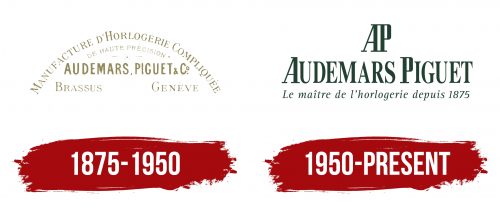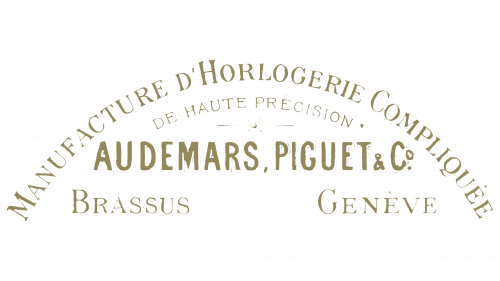The Audemars Piguet logo reflects the high precision of its mechanisms, underscoring the brand’s exclusivity. For many years, the brand has consistently maintained its high quality, thanks to the continuity of the family business and the preservation of unique manufacturing secrets. The temporal lines embedded in the fonts and inscriptions of the emblem symbolically connect the past and the present, highlighting the brand’s history and relevance in the modern world.
Audemars Piguet: Brand overview
In the small Swiss village of Le Brassus, located in the Joux Valley, the story of Audemars Piguet began in 1875. The region was well-known for its watchmakers, and it was here that Jules-Louis Audemars and Edward-Auguste Piguet, two young watchmakers, decided to join forces and establish their own company. Jules-Louis Audemars, born in 1851, came from a long line of watchmakers and learned to create intricate watch mechanisms early on. Edward-Auguste Piguet, born in 1853, also grew up in a family of watchmakers and showed exceptional talent for the trade. They officially started their business in 1875, when Piguet was 21 and Audemars was 23.
The company’s early years were challenging. The young craftsmen worked tirelessly to create intricate watch movements, which they sold to other manufacturers. Their reputation grew rapidly due to their designs’ superior quality and complexity.
In 1881, Audemars and Piguet formally registered their company under its now-famous name. From that moment, the brand began to expand quickly. In 1882, the company introduced its first pocket watch with a minute repeater, a feature that allowed the watch to chime the time on demand.
The company made history in 1889 by producing the world’s first wristwatch with a minute repeater. At that time, the most complex watch movements were typically reserved for pocket watches, and wristwatches were just beginning to gain popularity, making this a remarkable achievement.
At the turn of the 20th century, the company continued to impress the industry with its inventions. In 1899, the team introduced the “Grande Complication” pocket watch, a true masterpiece combining a minute repeater, perpetual calendar, and chronograph.
The early 20th century brought new challenges, especially with the decline in demand for luxury watches during World War I. However, the brand overcame these difficulties thanks to its innovative approach and technical expertise.
In the 1920s and 1930s, the company continued to produce groundbreaking timepieces, such as the first skeleton wristwatch in 1934 and the world’s thinnest watch in 1938.
After World War II, the Swiss watch industry faced tough times as competition from quartz watchmakers intensified. The company needed to find new ways to grow.
In 1972, a defining moment in the brand’s history occurred. The company launched the Royal Oak, the first luxury sports watch made of stainless steel. Designed by the famous Gérald Genta, it featured a distinctive octagonal bezel held by eight screws and an integrated bracelet. The Royal Oak’s introduction helped save the company from financial difficulties and created a new category of watches, blending sport and elegance.
In the following decades, the company continued to evolve the Royal Oak line with new models. In 1993, the Royal Oak Offshore, a bolder and sportier version of the original, quickly became popular with younger watch enthusiasts.
The 1990s and 2000s saw significant growth for the watchmaker. The company expanded internationally, opening numerous boutiques and solidifying its position as a top luxury watchmaker. In 2019, it made a major leap by introducing the Code 11.59 collection, which combined traditional and modern elements, showing that the brand is always pushing boundaries in design and technology.
By 2023, the company had established itself as one of the world’s most respected and innovative watchmakers. Remaining family-owned and independent, it continues to honor its traditions while embracing the future.
In nearly 150 years, the brand has grown from a small workshop into a globally recognized name, consistently committed to excellence, innovation, and the art of watchmaking. Its history is one of perseverance, overcoming challenges, and a dedication to crafting timeless masterpieces.
Meaning and History
What is Audemars Piguet?
This renowned Swiss watchmaker specializes in creating high-end mechanical watches that combine cutting-edge technology with centuries-old craftsmanship. The company is one of Switzerland’s few remaining independent family-owned watch manufacturers. One of the brand’s most famous creations is the Royal Oak — the first luxury sports watch made of stainless steel, distinguished by its innovative design featuring an integrated bracelet and an octagonal bezel with exposed screws. The company’s collection of complex watches includes models with tourbillons, minute repeaters, and perpetual calendars. Often included in the “big three” of Swiss watchmaking alongside Patek Philippe and Vacheron Constantin, the brand is recognized as one of the most prestigious watch companies in the world.
1875 – 1950
The first Audemars Piguet logo’s elements resemble a watch mechanism’s components. Although the logo is word-based, the inscriptions are arranged in an arc, as if outlining the shape of a clock face. At the top, it specifies the company’s main area of expertise: “Manufacture d’Horlogerie Compliquee,” which translates to “manufacture of complicated watch mechanisms.” This emphasized the brand’s specialization in creating intricate mechanisms for elite companies.
The phrase “De Haute Precision” was added to the center of the arc, highlighting the brand’s key strength—high precision. Between these elements, a delicate separator resembling clock hands is elegantly placed. At the center of the dial, the company name is displayed, consisting of the surnames of its founders—Jules Louis Audemars and Edward Auguste Piguet.
Below, on both sides of the name, positioned like hour markers at “3” and “9,” were key geographic locations for the company: Le Brassus — the village where production began, and Geneva — the capital of the Swiss watch industry. All elements of the visual logo were rendered in gold, underscoring the brand’s exclusivity and prestige.
1950 – today
Almost a century later, the company’s third-generation owners changed the emblem. The black color of the inscription now symbolizes a strict and reliable business partner, emphasizing the watches’ high precision and technical perfection.
At the top of the logo is a brief monogram composed of the first letters of the founders’ surnames, symbolically marking “noon” on the dial and representing the equal partnership between the two families. Below it is the company name, with the period between the surnames removed, making the brand unified and focused on its collective name rather than individual owners.
The letters of the visual mark reach upward, adding a sense of dynamism, while some characters feature thin serifs reminiscent of hour markers or the movement of the second hand. The font appears elegant, emphasizing the company’s aristocratic roots and commitment to high standards.
A fine inscription, “Le maître de l’horlogerie Depuis 1875,” located at the very bottom of the logo, refers to the brand’s mastery in watchmaking and the year of its founding, completing the composition and underscoring the brand’s heritage.






